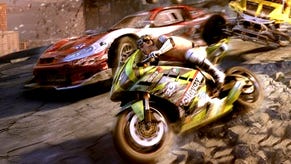MotorStorm: Pacific Rift
Cloudy.
Released alongside PlayStation 3 in March last year, MotorStorm was a raw, single-minded distortion of the successful WRC series that gave Evolution Studios the opportunity to make it in the first place, introducing multiple vehicle classes to the same track and playing host to the seemingly cunning technical innovation of persistent surface deformation. But while the rutted surfaces left in the wake of each lap's storm of thundering metal - and the implications for those that followed - made for easy headlines, given that they planted a flag for things that the then-four-hundred-quid console did over and above its predecessor, they never defined the first game. Instead we eulogised sensations dormant since the heyday of EA's SSX, which are now enjoying a renaissance best exemplified by the critical success of Black Rock Studios' excellent Pure a few weeks ago.
For MotorStorm: Pacific Rift, the sequel of only 18 months' construction, Evolution has left surface deformation alone to the extent that it's completely anonymous, preferring to spend its time delivering a measured response to criticisms of the first game. That means more definition for each each vehicle class, a tweaked boost system, and alternative routes designed to emphasise these changes across more numerous circuits. Impressively, the developer also finds time to repatriate split-screen racing after the former genre staple's spell in the downloadable wilderness.
This is always-on racing, another 16 tracks of constantly fighting for grip, dodging obstacles, searching out the optimal route, and straining for speed across grass, mud, rock and water, where you can never resort to autopilot because smashing your vehicle up inevitably follows, and having to rebuild speed is a price too high to pay often and still succeed. Making the most of your vehicle's turbo boost is still vital, and fiery lava levels and pooled water elsewhere play into the way you approach each track. Water has implications that taper from the biggest to the smallest vehicle classes, uncorking relentless top speed for big rigs ploughing the pacific surf and easing but not eliminating the heat build-up in other, faster classes like bikes and racing trucks, while nearby lava accelerates overheating considerably.

Individual circuit design is more elaborate than before, and each track now resides within a distinctive overarching label. Earth tracks are predictably dense and muddy affairs, while Air magnifies the first game's occasional rock-hopping and multiplies the number of big jumps to accentuate frantic last-minute adjustments before each ramp, often teasing you with several options. Fire tracks are a battle to avoid the grim, scorching embrace of molten rock gathered around unpredictable plateaus, inclines and tunnels hewn by the volcanic activity shown off in the background, and Water circuits are similar to Earth, but with more emphasis on plotting a route to either match your vehicle to or divide it from the streams and pools that will embolden or drown it. All are full of interlinked pathways that add or subtract from your momentum depending on what you're driving.
Some of these tracks are brilliant. The Edge takes Rain God Mesa's sliding-off-a-cliff bit and drags it out for most of its rocky duration, pocked with subtlety, and Caldera Ridge begins with a brilliant downhill rush trailed by a brief tweak to the camera angle, which also dares you to cut the corner with a jump that has to be inch-perfect. Sugar Rush is another highlight: a fantastic dash through a Swiss-cheese warren of rusted metal buildings, dividing its routes across several floors with patchwork ramps and gangways before sending you through a plantation thick with threat.
The rows of sugar cane pulverise bike-riders and overturn buggies and even heavier vehicles, but a monster truck can beat a path through them that weaker classes can follow, and while these little inter-vehicle harmonies are more occasional than perhaps expected, the different vehicle classes are individually refined too, most notably with the excellent bikes, for which steering is now responsive enough to justify their fragility. Buggies can boast of the same considered balance, but the tracks make different demands of them, and the new monster trucks are towering, top-heavy bullies. The main Festival mode, where players tackle around a hundred events gradually unlocked by an experience-based ranking system, plays on these distinctions to compensate for its inevitable repetition, and there are some great individual battles among its many race 'tickets', peaking with a lone bike fighting through a 15-strong pack of monster trucks and big rigs.



